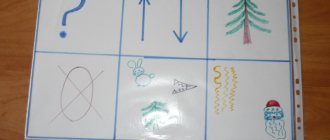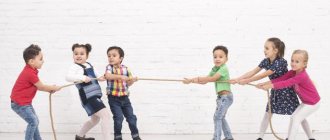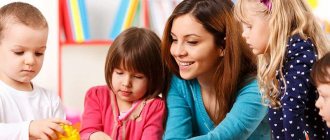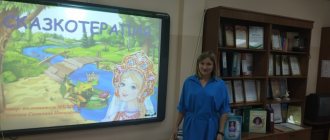Methodological development “Round table: “Difficulties of a teacher in working with modern parents”
Round table for teachers “Difficulties of a kindergarten teacher in working with modern parents”
Target:
searching for reserves for more efficient work.
Tasks:
1. Update existing problems in interaction with parents.
2. Promote increased self-confidence.
3. Train teachers in building effective communication with parents.
Progress of the lesson.
1 part. Warm up.
Welcoming participants, announcing the topic.
Communication plays a huge role in the life of any person, and a person’s mental health largely depends on its results - his mood, his feelings and emotions can be colored in positive or negative tones.
Exercise “Wish for Today”
to relieve emotional stress, have a positive attitude towards fruitful communication. I propose to start work by everyone expressing their wishes to each other for today. They should be short, preferably one word. One of the participants throws the ball to the person to whom he addresses the wish, and at the same time pronounces it. The one to whom the ball was thrown, in turn throws it to the next participant, expressing his wish for the day. We must carefully ensure that everyone has the ball and try not to miss anyone.
Despite the material accumulated by theory and practice on issues of interaction between kindergarten and family, teachers continue to experience difficulties in organizing communication with parents.
When working with families, it is important for a teacher to build a system in which both parties would interact as equal, equal partners in ensuring the comprehensive development of the child. This is quite difficult, since the teacher in an interaction situation must act in two roles: as an “official” - a representative of the educational institution and as a confidential interlocutor with whom you can share without fear of condemnation. The teacher’s communication skills play a major role in establishing positive contact with parents and in solving existing difficulties. I suggest we move on to the next part of our round table.
Part 2. Diagnostics.
Pedagogical training “Assessing the level of communication between teachers and parents.”
Teachers are asked a few simple questions. You need to answer quickly, clearly “yes”, “no”, “sometimes”.
1. You will have an ordinary conversation with one of the parents. Does her anticipation unsettle you?
2. Does the assignment to give a report or information to your parents cause you confusion and displeasure?
3. Do you put off an unpleasant conversation about a difficult child with his parents until the last moment?
4. Do you think that you should not personally talk with parents about the peculiarities of upbringing in the family, but it is better to conduct a questionnaire or a written survey?
5.You are asked to prepare a general parent meeting for parents of a preschool institution. Will you make every effort to avoid this assignment?
6. Do you like to share your experiences from communicating with parents with colleagues and management?
7.Are you convinced that communicating with parents is much more difficult than communicating with children?
8. Do you get annoyed if one of your students’ parents constantly asks you questions?
9. Do you believe that there is a problem of “educators and parents” and that they speak “different languages”?
10.Are you embarrassed to remind your parents about a promise they forgot to keep?
11.Do you feel annoyed when one of your parents asks you to help them sort out this or that complex educational issue?
12. Having heard the expression of a clearly erroneous point of view on the issue of education, would you prefer to remain silent and not enter into an argument?
13.Are you afraid to participate in the analysis of conflict situations between teachers and parents?
14. Do you have your own, purely individual criteria for assessing family education and do you not accept other opinions on this matter?
15. Do you think that it is necessary to educate parents, and not just children?
16.Is it easier for you to prepare information for parents in writing than to conduct an oral consultation?
Answer rating: “yes” - 2 points, “sometimes” - 1 point, “no” - 0 points.
The points received are summed up and it is determined which category the subject belongs to.
30-32 points. It is clearly difficult for you to communicate with your parents. Most likely, you are not good at communicating at all. This is your problem, since you yourself suffer more from this. But it’s not easy for the people around you either. It is difficult to rely on you in a matter that requires collective efforts. You try to keep contacts with your parents to a minimum. They are mostly formal. You try to shift the reasons for difficulties in communication to your parents. You are convinced that most parents are always dissatisfied, picky people, looking for only shortcomings in your work, and not wanting to listen to your opinion. Your inability to build communication with your parents leads to the fact that they also tend to avoid communicating with you. Try to become more sociable, control yourself.
25-29 points. You are closed and taciturn. A new job and the need for new contacts keep you out of balance for a long time. Communication with parents of students is difficult and not very pleasant for you. You know this feature of your character and are dissatisfied with yourself. However, for unsuccessful contacts with your parents, try to blame them more than your own communication skills. You have the power to change the characteristics of your character. Remember, participation in a common interesting activity allows you to easily find a common language with your parents!
19-24 points. You are to a certain extent sociable and feel quite confident in unfamiliar surroundings. You manage to establish contacts quite easily with the majority of parents in your group, but you do not strive to actively communicate with “difficult” parents. In an unfamiliar situation, you choose the “keeping an eye” tactic. The difficulties of communicating with your parents do not frighten you, but sometimes you are overly critical of them. These shortcomings can be corrected.
14-18 points. Your communication skills are normal. You are convinced that you can always find a “common language” with any parent. You willingly listen to your parents, are patient enough in communicating with them, and know how to defend your point of view without imposing it on others. Both individual and collective communication with parents does not cause you any unpleasant experiences. Parents also strive to maintain contact with you and seek your advice and support. At the same time, you do not like verbosity, excessive emotionality, and strive to avoid unnecessary conflicts.
9-13 points. You can be quite sociable. Constantly strive to engage in conversation with your parents, but often these conversations are meaningless. You love to be the center of attention and do not refuse anyone’s requests, although you cannot always fulfill them. Strive to express your own opinion to parents about how they are raising their children, and in any situation, give advice on what may irritate them. You are quick-tempered, but quick-witted. You lack patience and courage when faced with serious problems. If desired, however, you can build meaningful communication.
4-8 points. You are overly sociable. Strive to become a “friend” to every parent, to be aware of all their problems. Love to take part in all disputes and discussions. You always willingly take on any task, although you cannot always successfully complete it. You have your own opinion on any issue and always strive to express it. Perhaps for this reason, parents and colleagues treat you with caution and doubt. You should think about these facts.
3 points or less. Your sociability is painful. You are verbose and interfere in matters that have nothing to do with you. You undertake to judge problems in which you are completely incompetent. Willingly or unwittingly, you are often the cause of all sorts of conflicts, including among parents. When communicating with parents, you can be rude and familiar. You are characterized by bias and touchiness. You strive to bring any problem to public discussion. Serious communication with your parents is not for you. It’s difficult for those around you to deal with you. Try to think about why, despite all your efforts to establish communication with your parents, nothing comes of it? Cultivate patience and restraint, treat people with respect.
Part 3
.
Rules for effective communication with parents.
— When communicating with parents, you need to remember that communication has its own patterns. The basis of a person’s attitude towards us is laid in the first 15 seconds! In order to safely pass through the “minefield” of these first seconds, it is necessary to apply the “Rule of Three Pluses” (in order to win over your interlocutor you need to give him at least three psychological pluses.
The most universal ones are
• smile,
• name of the interlocutor
• compliment.
— In order for people to want to communicate with us, we ourselves must demonstrate our readiness to communicate with them. And the interlocutor must see this. A sincere friendly smile is required!
— A person’s name is the sweetest and most important sound for him in any language. It is important to use your first name when greeting. Not just nod or say: “Hello!”, but “Hello, Anna Ivanovna!”
During conflicts, wanting to relieve their severity, people subconsciously begin to use the name of their interlocutor more often (they can reach an agreement much faster). Because often we need not so much to insist on our own, but to see that people listen to us when they hear their name. Often the name is the decisive straw for things to turn out in our favor
In communication, the most useful is an indirect compliment; we praise not the person himself, but what is dear to him: a gun for a hunter, and a child for parents.
Busy, tired parents are especially vulnerable to their child's good and bad behavior. Therefore, you should not pay attention to the bad. First you need to talk about successes and only at the end can you tactfully tell about the problem areas of the child.
If you want to better understand yourself and be a confident person, understand other people, navigate the complex world of human relationships and be successful in communication. If a sense of emotional comfort is important to you, then it is important to consider: means of communication: words, facial expressions, gestures, voice intonation, eyes.
In addition to these techniques, there are other techniques for establishing good contact with your interlocutor.
1. Along with a smile, a friendly, attentive look (eye contact) is necessary. But you should not “drill” your interlocutor with your gaze.
2.Short distance and convenient location (from 50 cm to 1.5 m). This distance is typical for conversations between close acquaintances and friends, so the interlocutor subconsciously tunes in to listen and help us - thanks to this distance, we are perceived as “closer” to him. But do not cross the “borders” of your interlocutor’s personal space
3.Remove barriers that “increase” the distance in our perception of communication (table, book, sheet of paper in hands).
4.Use open gestures during the conversation, do not cross your arms or legs in front of you.
5. Maintain a state of safety and comfort with your entire appearance (lack of tension in the posture, sudden movements, clenched fists, a sideways glance, defiant intonation in the voice).
6.Use the joining technique, i.e. find a common “I”: “I’m the same, it’s the same with me!” Use the pronoun “You…” (You do this!”, “You must do this...!”) as rarely as possible, speak more often; “We”, “We are all interested in our children being healthy, able..., knowing...!”, “We are all concerned that children...'. “Our children...”, “We are united by a common cause - this is the upbringing of our children!”
Here are the most basic righties for establishing good personal contact and building effective communication and interaction with parents.
Part 4
Game “Magic Hat”
An exercise for teachers in giving a compliment to parents. (Participants stand in a circle)
Instructions: - While the music is playing, we pass the hat around the circle, when the music stops, the one who has it, puts it on himself and says a compliment to the person standing in the circle, calling him by name and patronymic. This can be a superficial compliment regarding clothes, jewelry, appearance, or you can also say something positive about the “child.” The “parent” to whom the “compliment” is addressed should accept it by saying: “Thank you, I’m very pleased! Yes, I really like this about myself too!”
At the end of the game, everyone returns to their seats.
Exchange of impressions: was it easy to give a compliment? Was it nice to receive the compliment?
The compliment should be sincere, preferably not direct, but indirect.
A.S. Makarenko noted that he began to consider himself a master when he learned to say the phrase “Come here” with 16 different voice intonations
Part 5
.
Exercise on the ability to intonate “Training intonation.”
Awareness of the importance of intonation to achieve the goal of influencing the teacher in communication with parents. Say the phrases:
I care about your child's success
I would like more frankness in our conversation
with shades of irony, reproach, indifference, demandingness, goodwill (intonations are indicated on the cards). At the end of the utterance, participants report which intonation is most acceptable when communicating with parents.
Relaxation.
Junior group. Early childhood, nursery. Children 1-4 years old
Report on the work on self-education “Fairy tale as a means of speech development in children 2-3 years old” FINAL REPORT ON THE WORK COMPLETED ON SELF-EDUCATION in the 2019/2020 academic year Topic: “Fairy tale as a means of speech development in children 2-3 years old”
Age group: first junior St. Petersburg 2022 The topic of self-education was chosen because the world of fairy tales is familiar from early childhood...
Self-education plan “Sensory development of young children through didactic games” Self-education plan on the topic: “Sensory development of young children through didactic games” Educator : Fadeeva N.N. Objectives of self-education: - expand knowledge about sensory education of children of early preschool age; — enrich the group’s developmental environment by...
Methodological development “Game technologies and their use in preschool educational institutions”
Yulia Yakovleva
Methodological development “Game technologies and their use in preschool educational institutions”
Gaming technologies have become an integral part of modern educational trends. Their skillful use by a teacher of a preschool educational institution (DOU)
makes the lesson interesting for students, and also creates the necessary conditions for the acquisition of new knowledge, skills and abilities in the leading form of activity for them - in the game.
The period of preschool childhood is unique in that it is at this age that a child absorbs information like a sponge and receives primary ideas about the world around him and his place in it. One of the most important forms of cognitive activity for a preschooler is play. This activity, properly organized by the teacher, contributes to the effective acquisition of information and skills by children, motivates them for independent research, and facilitates the socialization of students in the children's team.
Game technology is the organization of the pedagogical process in the form of various pedagogical games. This is a consistent activity of the teacher.
The use of gaming technologies in classes at preschool educational institutions :
• makes the child more active;
• increases cognitive interest;
• develops memory, thinking and attention;
• promotes the development of creative abilities, the development of speech skills.
Material learned during play is stored in children's memory for a longer time. In addition, according to the Federal State Educational Standard, training is in the following form:
• develops logical and critical thinking;
• develops the skill of building cause-and-effect relationships;
• fosters a creative approach to solving assigned problems;
• encourages initiative;
• promotes physical development.
The importance of gaming technology lies not in making it a means of entertainment for children, but in making it, if properly organized, a way of learning, an opportunity for students to self-realize and reveal their creative potential.
Goals and objectives of gaming technologies
For the entire preschool period, the goal of gaming technologies can be formulated approximately the same way: to give the child the opportunity to live through childhood through play before enrolling in school, while developing knowledge based on motivation. However, tasks can be specified based on the age group of students. The general tasks of gaming technologies , according to the Federal State Educational Standard, can be reduced to the following:
• Motivation of the child. The process of teaching a preschooler in a playful way awakens interest in activities, makes him happy and turns the acquisition of knowledge into an entertaining journey into the world of new information and skills.
• Self-realization. It is through play that a child learns to explore his or her capabilities, take initiative, and make informed choices.
• Development of communication skills. In the game, a preschooler learns to communicate with peers and with adults, tries on the role of both a leader and a performer , trains to find compromises and get out of conflict, and develops speech.
• Play therapy . The game can rightfully be considered a proven way to relieve stress and overcome difficulties from different areas of life.
The development of modern society requires generalization and systematization of the experience of pedagogical innovations and the results of psychological and pedagogical research. One of the ways to solve these problems is a technological approach to organizing educational work with children.
In preschool education, pedagogical technology represents a set of psychological and pedagogical approaches that define a set of forms, methods , methods, teaching techniques, educational means for the implementation of the educational process in preschool educational institutions.
At the present stage, gaming can be used as an independent :
— to master the educational topic or content of the material being studied;
- as a GCD or part thereof
- as part of the educational program formed by the preschool educational institution team.
The main feature of a pedagogical game in gaming technology is a clearly defined learning goal and the corresponding pedagogical results, characterized by an educational and cognitive orientation.
The place and role of using games in the educational process, the combination of game and learning elements largely depend on the teacher’s understanding of the functions and classification of pedagogical games.
Let's consider groups of games according to the nature of the gaming methodology :
Group I object games, such as manipulations with toys and objects. Through toys, objects, children learn shape, color, volume, material, the animal world, the human world, etc.
Group II games are creative, plot-role-playing, in which the plot is a form of intellectual activity.
Among the authors of modern pedagogical technologies
stands out: Technology of organizing a role-playing game by N. Ya. Mikhailenko, N. A. Korotkova.
A role-playing game includes the plot of the game, content, and role.
The plot is a sphere of activity that is reproduced by children, and is the child’s reflection of certain actions, events, relationships from the life and activities of others.
Content is what is reflected by the child as an integral and characteristic moment of the activity and relationship between an adult and their everyday, work, and social life.
A role is a means of realizing the plot and the main component of a role-playing game.
As proven in the studies of N. Ya. Mikhailenko and E. E. Korotkova, games develop in the following sequence:
– younger age – role-playing game (dialogue game)
;
-middle age – play with rules, theatrical play;
- older age – game with rules, director’s (game – fantasy, game – dramatization)
N. Ya. Mikhailenko identifies the following principles for organizing role-playing games in preschool childhood:
1. The teacher must play with the children.
2. The teacher should play with children throughout preschool childhood, but at each stage the game should be developed in such a way that the children immediately “discover”
and learned a new, more complex way of building it.
3. Starting from an early age and further at each stage of preschool childhood, when developing gaming skills, it is necessary to simultaneously orient the child both to the implementation of a gaming action and to explaining its meaning to partners - an adult or a peer.
Creative, plot-based role-playing games of an educational nature do not simply copy the life around them, they are a manifestation of the free activity of preschoolers, their free imagination.
III group of games, which are used as a means of developing children’s cognitive activity, are games with ready-made rules (usually called didactic)
.
used with preschoolers : games with rules;
games with rules established during the game; a game where one part of the rules is specified by the conditions of the game, and is established depending on its progress. As a rule, they require the preschooler to be able to decipher, unravel, and unravel. The more skillfully a didactic game is composed, the more skillfully the didactic goal is hidden. The child learns to operate with the knowledge invested in the game unintentionally, involuntarily, while playing.
The value of a didactic game is determined not by what reaction it will evoke from children, but by its effectiveness in solving a particular problem for each child.
IV group of games, intellectual games: exercise games, training games that affect the mental sphere; intellectual games like “Lucky Chance”
,
"What?
Where? When?" etc. Data is an important component of educational work of a cognitive nature.
Based on competition, through comparison they show playing children their level of preparedness and fitness, suggest ways of self-improvement, and therefore stimulate their cognitive activity.
Game technology ensures the unity of the emotional and rational in learning; they are aimed at developing creativity, initiative in children, and creating joy. During the game, due to the flexibility of gaming technology , the child is faced with situations of choice in which he shows his individuality. The idea of variability, freedom of choice of tasks and organizational forms of activity - one of the leading ideas of modern pedagogy - receives opportunities for its implementation gaming technology
The advantage of game-based learning technologies is that they arouse increased interest and positive emotions in children, and help to concentrate attention on the educational task, which becomes not imposed from the outside, but a desired, personal goal. Solving an educational problem during a game involves less expenditure of nervous energy and minimal volitional efforts. As experience shows, acting in a game situation close to real life conditions, preschoolers more easily learn material of any complexity.
Methodological development for teachers of preschool educational institution “Modern pedagogical technologies”
METHODOLOGICAL DEVELOPMENT FOR KINDERGARTEN TEACHERS
CLASSIFICATION for practical use
Modern educational technologies in preschool educational institutions
Modern pedagogical technologies in preschool education are aimed at implementing state standards for preschool education.
Pedagogical technology
is a set of psychological and pedagogical attitudes that determine a special set and arrangement of forms, methods, methods, teaching techniques, and educational means.
Modern educational technologies include
:
1. Health-saving technologies
Purpose
health-saving technologies is to provide the child with the opportunity to maintain health, to develop in him the necessary knowledge, skills and habits for a healthy lifestyle.
The following classification of health-saving technologies is distinguished (in relation to preschool educational institutions):
- medical and preventive (
ensuring the preservation and enhancement of children's health in accordance with medical requirements and standards - technologies for organizing monitoring of the health of preschool children, monitoring children's nutrition, preventive measures, a health-preserving environment in preschool educational institutions);
- physical education and health
(aimed at the physical development and strengthening of the child’s health - technologies for the development of physical qualities, hardening, breathing exercises, etc.);
- ensuring the socio-psychological well-being of the child
(ensuring the mental and social health of the child and aimed at ensuring the child’s emotional comfort in the process of communicating with peers and adults in kindergarten and family;);
- health preservation and health enrichment for teachers
(aimed at developing a culture of health among teachers, at developing the need for a healthy lifestyle; preserving and stimulating health (technology of using outdoor and sports games, gymnastics (for the eyes, breathing, etc.), rhythmoplasty, dynamic pauses, relaxation);
- educational
(nurturing a culture of health in preschool children, person-centered education and training);
- healthy lifestyle training
(technologies for using physical education classes, problem-based games (game training, game therapy), self-massage); correctional (art therapy, music technology, fairy tale therapy, psycho-gymnastics, etc.)
2. Technologies of project activities
Target:
Development and enrichment of social and personal experience through the inclusion of children in the sphere of interpersonal interaction.
Teachers who actively use project technology in the upbringing and teaching of preschoolers unanimously note that life activities organized according to it in kindergarten allow them to get to know the students better and penetrate into the child’s inner world.
Classification of educational projects:
- "game"
- children's activities, participation in group activities (games, folk dances, dramatizations, various types of entertainment);
- "excursion"
aimed at studying problems related to the surrounding nature and social life;
- "narrative"
in the development of which children learn to convey their impressions and feelings in oral, written, vocal artistic (painting), musical (playing the piano) forms;
- "constructive"
aimed at creating a specific useful product: making a birdhouse, arranging flower beds.
3. Research technology
4. Information and communication technologies
The world in which a modern child develops is fundamentally different from the world in which his parents grew up. This places qualitatively new demands on preschool education as the first link of lifelong education: education using modern information technologies (computer, interactive whiteboard, tablet, etc.).
- Personally-oriented technology
Personality-oriented technologies place the child’s personality at the center of the entire system of preschool education, ensuring comfortable conditions in the family and preschool institution, conflict-free and safe conditions for its development. Within the framework of personality-oriented technologies, independent areas stand out:
- humane-personal technologies
, distinguished by their humanistic essence and psychological and therapeutic focus on providing assistance to a child with poor health during the period of adaptation to the conditions of a preschool institution.
The implementation of this technology includes upholstered furniture, many plants that decorate the room, toys that promote individual play, and equipment for individual activities. Music and physical education rooms, a room for the environmental development of preschoolers and productive activities, where children can choose an activity of interest. All this contributes to comprehensive respect and love for the child, faith in creative forces, there is no coercion here. Collaboration technology
implements the principle of democratization of preschool education, equality in the relationship between teacher and child, partnership in the system of relationships “Adult - child”. The teacher and children create conditions for a developing environment, make manuals, toys, and gifts for the holidays. Together they determine a variety of creative activities (games, work, concerts, holidays, entertainment).
6.Portfolio technology for preschoolers
A portfolio is a collection of a child’s personal achievements in various activities, his successes, positive emotions; it is a unique route for the child’s development.
7. Technology "Teacher's Portfolio"
Modern education needs a new type of teacher:
- creative thinkers who are proficient in modern educational technologies,
- methods of psychological and pedagogical diagnostics, ways of independently constructing the pedagogical process in the conditions of specific practical activities, and the ability to predict one’s final result.
A portfolio allows you to take into account the results achieved by a teacher in various types of activities (educational, educational, creative, social, communicative), and is an alternative form of assessing the professionalism and performance of a teacher.
8. Gaming technology
It is built as a holistic education, covering a certain part of the educational process and united by common content, plot, and character.
9. TRIZ technology
TRIZ (the theory of solving inventive problems), which was created by the scientist-inventor T.S. Altshuller.
The teacher uses non-traditional forms of work that put the child in the position of a thinking person. TRIZ technology adapted for preschool age will allow you to educate and train a child under the motto “Creativity in everything!” Preschool age is unique, because as a child is formed, so will his life, which is why it is important not to miss this period to reveal the creative potential of each child.
The purpose of using this technology in kindergarten is to develop, on the one hand, such qualities of thinking as flexibility, mobility, systematicity, dialecticity; on the other hand, search activity, the desire for novelty; speech and creative imagination.
And I would like to end with the words of Charles Dickens
A person cannot truly improve unless he helps others improve.
Create it yourself.
Just as there are no children without imagination, there is no teacher
without creative impulses.
I wish you creative success!






